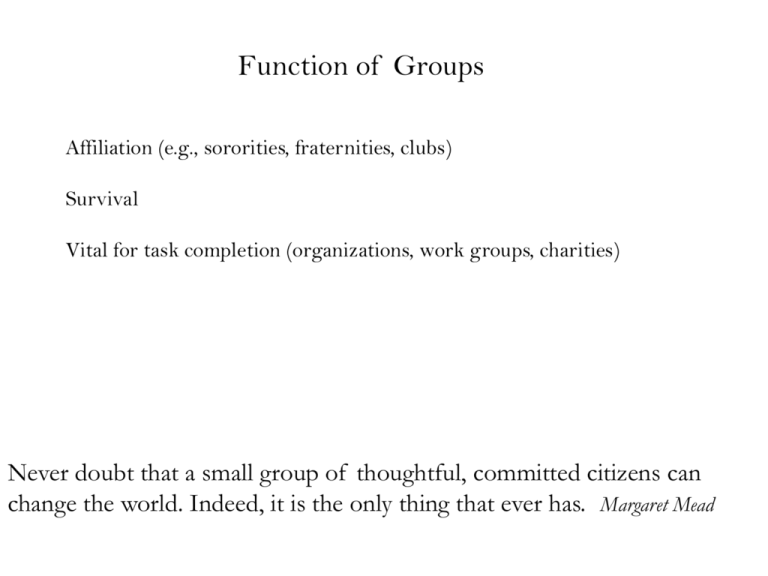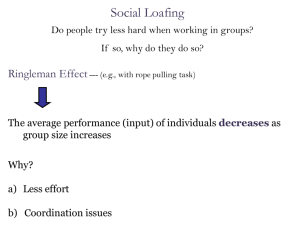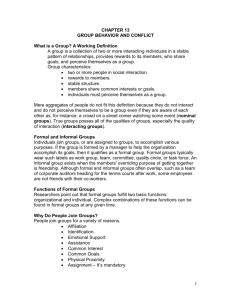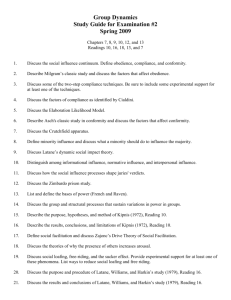Loafing and Females in Leadership Slides
advertisement

Function of Groups Affiliation (e.g., sororities, fraternities, clubs) Survival Vital for task completion (organizations, work groups, charities) Never doubt that a small group of thoughtful, committed citizens can change the world. Indeed, it is the only thing that ever has. Margaret Mead Group Processes Social Loafing Do people try less hard when working in groups? Does social loafing occur? Ringleman Effect? The average performance (input) of individuals decreases as group size increases Ringelmann Findings Individuals Individual Efforts (Sum) Group Effort Group/Individ ual Ratio 1-7 764 480 .63 8-14 516 432 .84 15-21 533.7 435.4 .82 22-28 575.5 471.2 .82 15-28 1109.2 858.9 .78 Why? a) Less effort b) Coordination issues Precursor to the Latane et al study (Ingram et al, 1974) Yelling (& clapping) study by Latane, Williams, & Harkins Procedure? Alone In actual groups In pseudo-groups Less individual effort when in groups, even in “groups” when no one was present (but people thought they were) Potential productivity Actual groups Pseudo-groups 10 Reduced effort (Social loafing) 8 Sound pressure per person 6 Coordination loss 4 2 1 Group size 2 6 Social Loafing on a More Complex Task Social Loafing on a More Complex Task (cont.) Men, Women, and Leadership Characteristics Procedure? Survey: List of 92 adjectives rated on a 5-point scale from (1) “Not Characteristic to (5) “Characteristic” Ratings on: Men in General, Women in General, and Successful Manager in General Men, Women, and Leadership Characteristics Results – Ratings by males? Men, Women, and Leadership Characteristics (cont.) Results – Rating by females? Men, Women, and Leadership Characteristics (cont.) Results? High agreement in ratings Less agreement on ratings of women by males and females Men, Women, and Leadership Characteristics (cont.) Results regarding specific trait differences? Males higher ratings on “Dominant-Aggressive” characteristics – e.g., competitive, need for power, aggressive, assertive (especially by male raters) Females higher ratings on “Social Humanitarian” characteristics - e.g., sympathetic, desire for friendship, helpful (especially by female raters) Big Picture Implications? Less representation of females in business (e.g., CEOs), politics (e.g., U.S. Senate), academic administration (e.g., universities) Females in Leadership Positions - Percent of females in US Senate? Barbara Mikilski Mary Landrieu Dianne Feinstein Barbara Boxer Parry Murray 20 Susan Collins Maria Cantwell Debbie Stabenow Claire McCaskill Kay Hagan Lisa Murkowski Amy Klobuchar Jeanne Shaheen Kirsten Gillibrand Kelly Ayotte Tammy Bladwin Deb Fischer Heidi Heitkamp Mazie Hirono Elizabeth Warren Female CEOs of Fortune 500 Companies? 23 (Link) Company GENERAL MOTORS HEWLETT-PACKARD IBM PEPSICO A.D.M LOCKHEED MARTIN CEO Mary Barra 2014 Company AVON 2011 = 12; 2012 = 18 CEO Sherilyn McCoy 2012 Meg Whitman 2011 SEMPRA ENERGY Debra Reed 2011 Virginia Rometty 2012 GUARDIAN LIFE Deanna Mulligan 2011 Indra Nooyi 2006 CAMPBELL SOUP Denise Morrison 2011 Patricia Woertz 2006 MYLAN Heather Bresch 2012 Marillyn Hewson 2013 INGREDION Ilene Gordon 2009 DUPONT Ellen Kullman 2009 CH2M HILL Jacqueline Hinman 2014 MONDELEZ Irene Rosenfeld 2006 GRAYBAR ELECTRIC GENERAL DYNAMICS Phebe Nokakovic 2013 GANNETT TJX Carol Meyrowitz 2007 FRONTIER COMM. XEROX DUKE ENERGY Ursula Burns 2009 Lynn Good 2013 YAHOO Kathleen Mazzarella 2012 Gracia Martore 2011 Maggie Wilderotter 2006 Marissa Meyer 2012 Gender and Leadership: Recent Findings Females as CEOs --increase in stock price Survey of over 60,000 direct reports But, it depends on industry No gender preference for one’s own boss Price goes up higher if female CEO is head of female-dominated business, otherwise small decrease in stock price (Cooke & Glass, 2011) “Ideal” boss: 54% -- No Preference 13% -- Female Preference 33% -- Male Preference • Small but significant preference for opposite-sex bosses • Increased preference for stereotypical female leader characteristics (sensitive, supportive) vs. direct, forceful. Study by Elesser & Lever (2011) Zajonic’s Theory of Social Facilitation Well-learned (dominant) response Poorly learned or novel (non-dominant) response Social Facilitation Performance enhanced Arousal caused by presence of others Social Interference Performance hindered Charting the Course of Groupthink Irving Janis depicted groupthink as a kind of social disease, complete with antecedents and symptoms, that increased the chance of making a bad decision. (Based on Janis, 1982.) Symptoms Antecedents • High cohesiveness • Isolation • Directive leader • Homogeneous members Stressful situations • Overestimation of the group (invulnerability) • Close-mindedness • Rationalization • Increased pressures toward uniformity • “Mindguards” and pressure on dissenters • Self-censorship • Illusion of unanimity Consequences Incomplete survey of alternatives Poor information search Failure to examine risks of preferred choice High probability of a bad decision Other Group Decision-Making Phenomena Collective Entrapment --- The more effort used to make a decision, the greater likelihood of sticking to that decision (even if it’s been shown to be incorrect) Common Knowledge Effect --- Information held by most group members exerts a stronger impact on final decisions ~ Social Identity Theory ~ [In-Group Bias] They tendency to link one’s self-concept and self esteem with the status and/or behavior of groups Also, people tend to reward members of ingroups and disfavor those in outgroups (e.g., Minimal Group Paradigm) --Basking in Reflected Glory --Favorite Football Team wins --- “We;” More likely to wear team t-shirt Favorite Football Team loses --- “They” In and Out-Groups Bias • Liking, spend time with leader • Challenging, visible jobs • Better memory for good behavior In-group characteristics • Treated warmly • Performance evaluations • Allocation of rewards • Less desirable jobs • Less time spent with supervisor • Treated formally • Lower performance evaluations • Less rewards Out-group characteristics Are Groups Good or Bad? Gustav Le Bon (1895) stated that leaders can manipulate citizens by simplifying ideas, substituting affirmation and exaggeration for proof, and by repeating points over and again. (From: Forsyth, 2010) --- Concept of “deindividuation” LeBon and Tarde --- Mass hysteria








